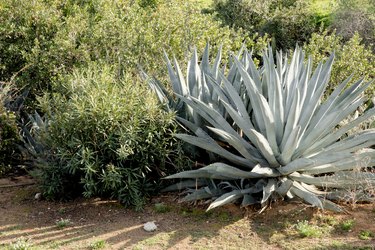Agave plants (Agave spp.) are succulents that feature thick, water-filled leaves. Some species are used to make sweet agave syrup, and one species is used to make tequila. These plants thrive in dry, hot conditions and can live for long periods without water. If the weather is too harsh, agave plants become dormant, shedding their leaves until they take in water again. Agave plants can also suffer from a variety of diseases and pest infestations. Examining your agave plant's symptoms is the best way to determine the best treatment to nurse the plant back to health.
Freezing Temperatures
Video of the Day
Examine the leaves of the agave plant for black areas. Freezing temperatures cause the agave leaves to turn black, become very dry and eventually fall off. An agave plant usually recovers from external freeze damage when freezing temperatures only last a few hours. To avoid that, move the agave near the house or in a patio area that receives warmth from the house. Carefully remove the agave plant from the soil using a garden shovel.
Video of the Day
Choose an area with well-draining soil, and plant the agave so that the agave tissue remains above the soil. Succulents that are planted too deeply succumb to root and/or crown rot and eventually die.
Sun Damage
Examine the agave for yellowing leaves and dropping leaves that might be caused by too much sunlight. Replant the agave in an area that gets some shade and some direct sun. Try finding a spot near other plants or trees for a decent amount of coverage throughout the day.
Spore Lesions
Examine your agave plant for orange or red spores or lesions on the leaves. Lesions form as a result of the spores during wet weather, because rain or irrigation can cause the spores to spread over the plant.
Remove any spotted leaves and avoid watering the plant with a sprinkler if you find spores or lesions. Protect the agave from the rain with a plastic covering until the lesions disappear.
Fungus Infection
Check for soft, dark spots on the upper area of your agave plant. A fungus from the Helminthosporium genus forms spores that can rot agave leaves when carried by wind and rain.
Apply fungicides that are safe to use on agave to diminish the spread of the fungus by spraying both the upper and lower portions of the leaves. Spray fungicides around the agave base also. Also remove any excessively infected plants that are nearby to prevent spreading the spores.
Insect Damage
Examine the agave plant for wilted or yellow, scarred leaves. Female weevils lay eggs inside the base of the plant, causing wilting leaves and plant collapse, while the agave plant bug causes leaves to turn yellow.
Apply broad-spectrum insecticides following all label directions in the spring to control the agave weevil and plant bugs. Spray the insecticides around the plant base to thoroughly destroy any weevils living in the soil. Spray the insecticide on the upper and lower surfaces of all leaves to prevent agave any infestation.
Keep in Mind
The environment plays a large part in the agave's health. So if your agave is dying, transplant it to another area that has good drainage and protection from hail, cold and excessive sunlight.
And regardless of what you're doing with your agave plant, always wear protective goggles, gloves and clothing when using fungicides and insecticides.
